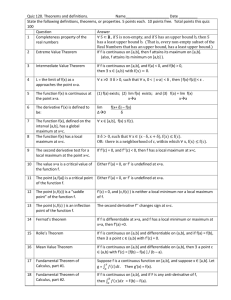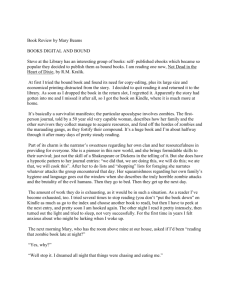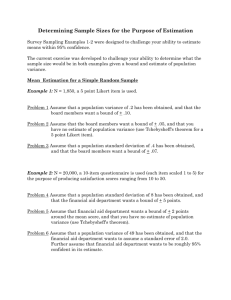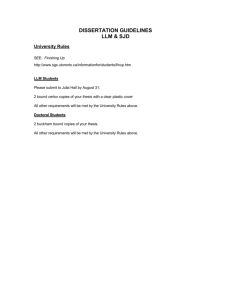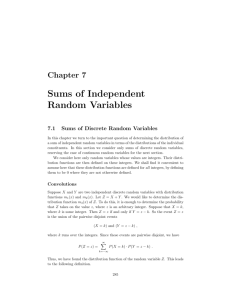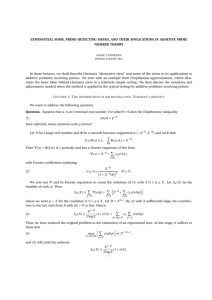Holowinsky`s work
advertisement
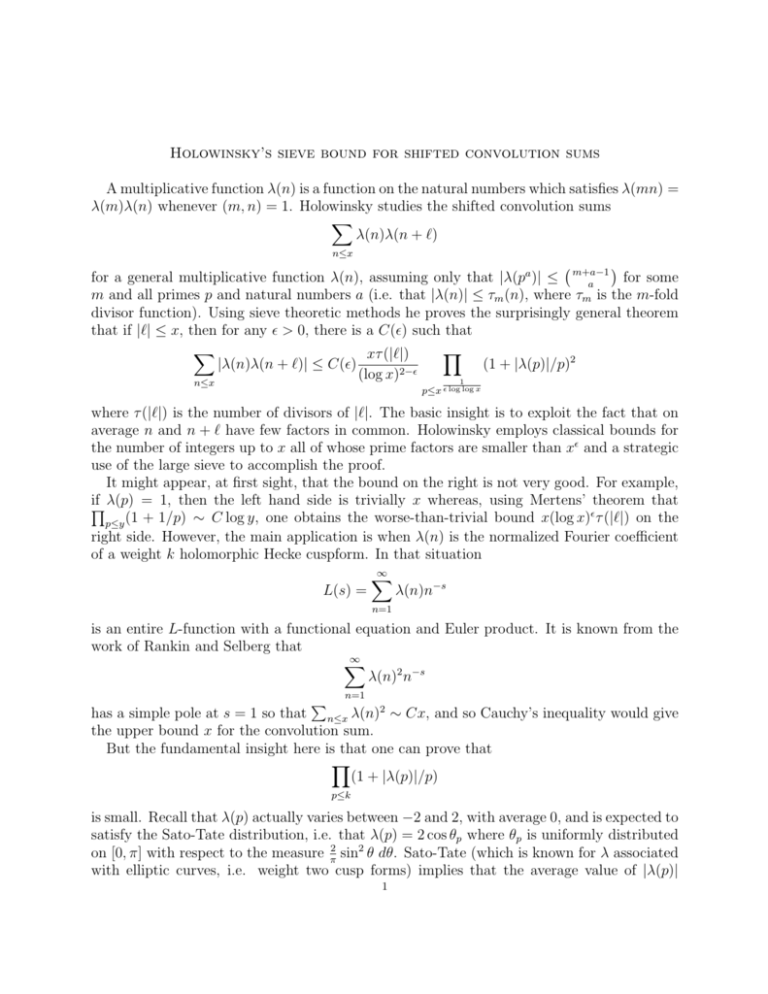
Holowinsky’s sieve bound for shifted convolution sums A multiplicative function λ(n) is a function on the natural numbers which satisfies λ(mn) = λ(m)λ(n) whenever (m, n) = 1. Holowinsky studies the shifted convolution sums X λ(n)λ(n + `) n≤x for a general multiplicative function λ(n), assuming only that |λ(pa )| ≤ m+a−1 for some a m and all primes p and natural numbers a (i.e. that |λ(n)| ≤ τm (n), where τm is the m-fold divisor function). Using sieve theoretic methods he proves the surprisingly general theorem that if |`| ≤ x, then for any > 0, there is a C() such that X Y xτ (|`|) |λ(n)λ(n + `)| ≤ C() (1 + |λ(p)|/p)2 2− (log x) 1 n≤x p≤x log log x where τ (|`|) is the number of divisors of |`|. The basic insight is to exploit the fact that on average n and n + ` have few factors in common. Holowinsky employs classical bounds for the number of integers up to x all of whose prime factors are smaller than x and a strategic use of the large sieve to accomplish the proof. It might appear, at first sight, that the bound on the right is not very good. For example, if Q λ(p) = 1, then the left hand side is trivially x whereas, using Mertens’ theorem that p≤y (1 + 1/p) ∼ C log y, one obtains the worse-than-trivial bound x(log x) τ (|`|) on the right side. However, the main application is when λ(n) is the normalized Fourier coefficient of a weight k holomorphic Hecke cuspform. In that situation ∞ X λ(n)n−s L(s) = n=1 is an entire L-function with a functional equation and Euler product. It is known from the work of Rankin and Selberg that ∞ X λ(n)2 n−s n=1 has a simple pole at s = 1 so that n≤x λ(n)2 ∼ Cx, and so Cauchy’s inequality would give the upper bound x for the convolution sum. But the fundamental insight here is that one can prove that Y (1 + |λ(p)|/p) P p≤k is small. Recall that λ(p) actually varies between −2 and 2, with average 0, and is expected to satisfy the Sato-Tate distribution, i.e. that λ(p) = 2 cos θp where θp is uniformly distributed on [0, π] with respect to the measure π2 sin2 θ dθ. Sato-Tate (which is known for λ associated with elliptic curves, i.e. weight two cusp forms) implies that the average value of |λ(p)| 1 2 8 is 3π = 0.848826 which is smaller than 1. While we don’t know Sato-Tate in general, nevertheless we can prove that the average of |λ(p)| is smaller than one. By the RankinSelberg theorem (or by Shimura’s theorem on the holomorphy of the symmetric square Lfunction), |λ(p)|2 is 1 on average, and by work of Kim and Shahidi theorem on the holomorphy of the symmetric fourth power, it follows that |λ(p)|4 is 2 on average. Using, for example, the inequality 8 + 11x2 − x4 |x| ≤ 18 which is valid for −2 ≤ x ≤ 2 it follows that the average of |λ(p)| is at most 17/18. Thus, Holowinsky’s sieve bound leads to a savings of a power of a logarithm in the bound for the shifted convolution sum of the coefficients of a holomorphic cusp form. (Similar ideas to those in this paragraph were developed by Elliott, Moreno, and Shahidi building on earlier ideas of Elliott and Rankin.) Following Sarnak and Luo, the relevance of the shifted convolution to mass equidistribution arises from the use of Poincare series in the computation of Z φ(z)Fk (z)dµ F where φ(z) is a Maass cusp form (or an Eisenstein series), F is the fundamental domain for the upper half-plane modulo SL(2, Z) and Fk (z) = y k |f (z)|2 where ∞ X λ(n) exp(2πinz). f (z) = n=1 The unfolding method allows one to bound the above integral in terms of the shifted convolution sums of λ(n): X λ(n)λ(n + `) n≤k where k is the weight. We expect cancellation in this sum due to the sign variations of the λ(n), and considerations such as the Riemann Hypothesis for the associated L-function. Holowinsky’s innovation is to go a different route, using the insight gained from Sato-Tate as described above and bound the sum with absolute values. In this way, he obtains Q Z p≤k (1 + |λ(p)|/p) φ(z)Fk (z)dµ (log k)1− L(1, sym2 f )1/2 F where L(1, sym2 f ) is the symmetric square L-function associated with f evaluated at the edge of the critical strip. From this bound, Holowinsky shows that for all but k forms the integral above tends to 0 and the values of Fk are uniformly distributed.


